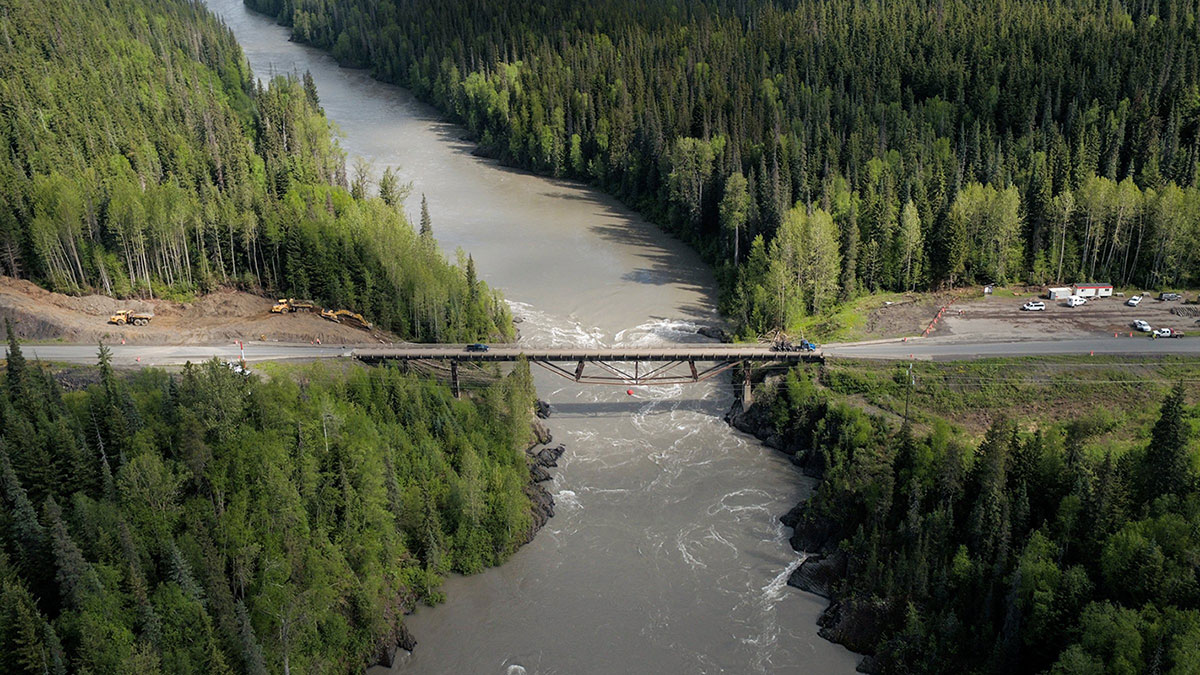A proposed northern British Columbia liquified natural gas project threatens vital salmon habitat, and Gitanyow cultural practices and economic opportunities, the Gitanyow Hereditary Chiefs argued recently in court.
In a February hearing, following a petition filed in October, they told a B.C. Supreme Court Justice that the provincial government’s decision to exclude Gitanyow from consultations on the building of the LNG project violates their rights.
The chiefs are seeking to overturn a decision by the B.C. Environmental Assessment Office that didn’t include the Gitanyow in discussions about the proposed Ksi Lisims LNG project which would see a terminal built at the mouth of the Nass River. This is critical salmon habitat for Chinook salmon, a species already at risk. An LNG terminal would disrupt delicate salmon habitats the Gitanyow rely on for food and cultural practices. The project is jointly proposed by Rockies LNG Limited Partnership, Texas-based Western LNG LLC and the Nisga’a Lisims Government.
Canada’s National Observer contacted the assessment office, which said it is unable to comment as the matter is currently in court. Ksi Lisims LNG has yet to respond to an email inquiry.
The Ksi Lisims LNG terminal, where gas from the Prince Rupert Gas Transmission pipeline will be cooled and shipped overseas, will be at a site called Wil Milit, off Pearse Island in northern B.C.
Studies have shown that juvenile salmon found in the area of the LNG facility could be migrating from different parts of the Nass River watershed, including Gitanyow territory, to the Pacific Ocean. “If they do migrate from Gitanyow territory, there will be an impact to our fisheries,” said Tara Marsden, Wilp sustainability director for the Gitanyow Hereditary Chiefs.
Gitanyow’s legal challenge argues the environmental assessment process was fundamentally flawed. It concluded consultation with the Gitanyow wasn’t necessary because the LNG project did not affect their lands or rights, a finding the Gitanyow reject.
“The government’s been very intransigent in its response: ‘We have no duty to consult you. We’re going to take care of the fish. Don’t worry if there’s any impact, we will mitigate them’,” Marsden said.
Arguments against consulting with Gitanyow First Nation included the assertion that their territory — 80 kilometres from the site — is too far from the project, she added. However, the Haida Nation, which is more than 100 kilometres away but lays claim to waters closer to the LNG site was consulted. The government “threw everything at the wall” to avoid meaningful consultation with Gitanyow, Mardsen said.
She would like to see research, like genetic testing on juvenile salmon in the project area or an analysis of the bull kelp habitat that is critical to juvenile salmon survival, before the project goes ahead.
Michael Price, a conservation scientist expert, who works in the Nass and Skeena watersheds and was asked by the Gitanyow to review the assessment, stated its conclusion is “premature and scientifically indefensible.” He also pointed out there is no plan in place to mitigate the destruction of salmon habitat.
As part of their land and environmental protection, the Gitanyow have had a land use plan with the provincial government since 2012.
The Gitanyow Lax’yip land use plan is a comprehensive framework to protect the territory’s ecosystems and support sustainable development. The Gitanyow have their own governance process, the Wilp Sustainability Assessment Process, where any project on Gitanyow lands or affecting their rights must go through consultation and consent. Despite these protections, the Gitanyow were not notified about the Ksi Lisims LNG project, which they say breaches not only their rights under Canadian law, but also their own governance.
Three decisions
The future of the pipeline and terminal project will be determined by three key decisions.
First, the province must assess whether the pipeline project has met the “substantial start” criteria. If the project is deemed to be substantially underway, it could bypass further consultation and limit Gitanyow’s involvement in the environmental assessment process. A draft report on the Prince Rupert Gas Transmission pipeline application has been shared with Indigenous nations, but it didn’t decide one way or the other. That leaves a big question mark, Marsden said.
The Gitanyow argue the project is not substantially underway and the initial environmental certificate that greenlit the project has expired and is therefore invalid. Gitanyow will respond to the draft report this week.
While the Gitanyow have issued a court challenge against the terminal project, a number of participating First Nations are working through their own environmental concerns through the assessment office’s dispute resolution process. Complaints by the Lax Kw’alaams Band, Metlakatla First Nation and Gitga’at First Nation have caused the environmental assessment to pause until the disputes are resolved.
“There’s a growing number of Indigenous nations who are now concerned or opposing both the terminal and the pipeline,” Marsden said.
The third decision is the forthcoming ruling by the courts on the Gitanyow challenge, expected next month. If the court rules in favour of Gitanyow and decides the government ignored their consultation duties, it could pause the environmental assessment and allow Gitanyow to have a government-to-government dialogue with the province, Marsden noted. It could also set a precedent for future consultations with Indigenous nations on similar projects.
But if the court rejects Gitanyow’s application, the project could proceed and represent a big blow to their ability to protect their traditional lands and resources.
“We’re in court to fight for our way of life,” said Simogyet Malii/Glen Williams, a Gitanyow Hereditary Chief. “If this project is built, we will lose our salmon habitats and at-risk Chinook salmon will be pushed even closer to extinction.”
Read the article by Sonal Gupta at Canada’s National Observer website.
